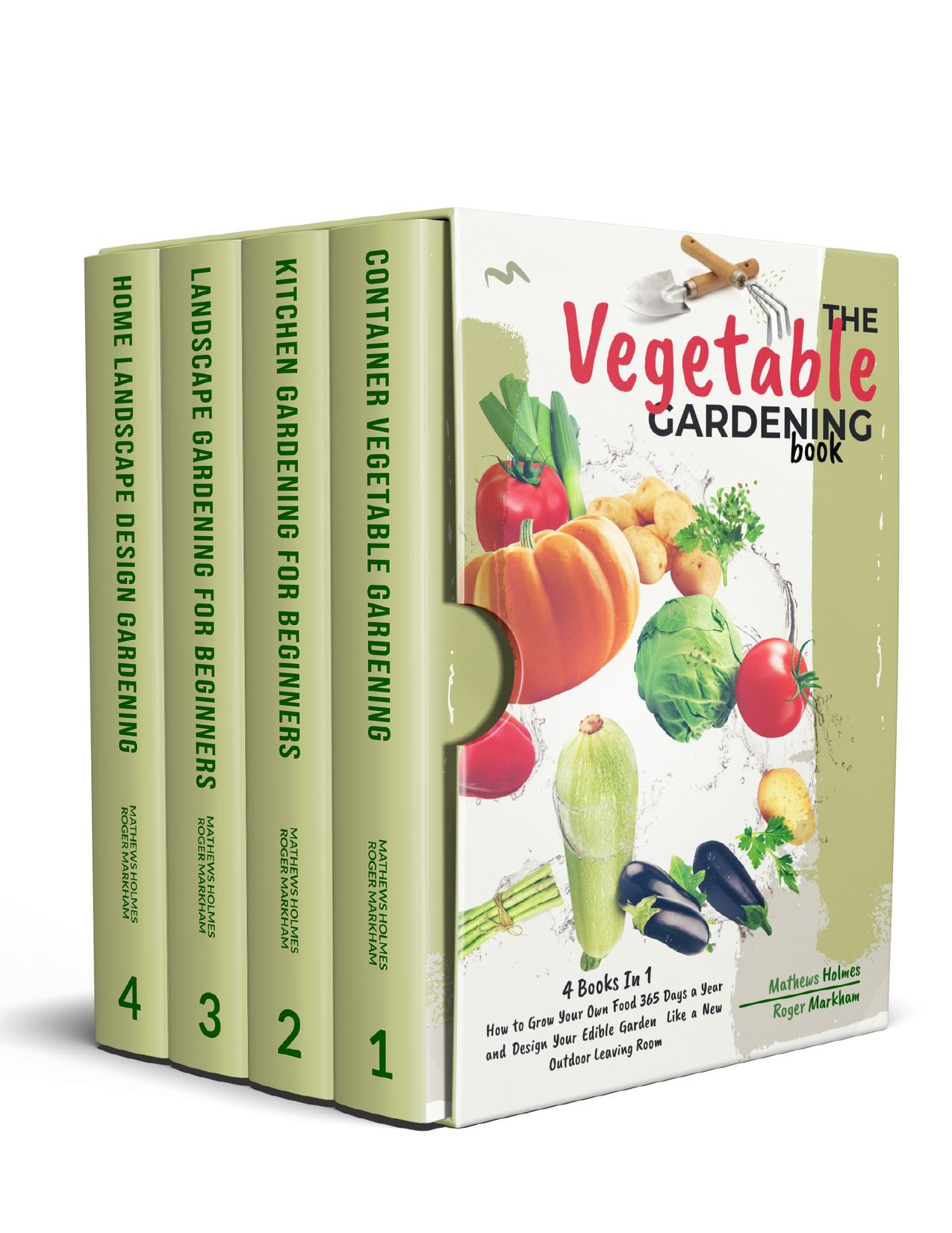The Vegetables Gardening : 4 Books In 1, How to Grow Your Own Food 365 Days a Year and Design Your Edible Garden Like a New Outdoor Living Room (The Complete Gardeners Guide) by Markham Roger & Holmes Mathews

Author:Markham, Roger & Holmes , Mathews [Markham, Roger]
Language: eng
Format: epub, pdf
Published: 2020-12-20T16:00:00+00:00
CHAPTER 2: VEGETABLE INSPIRATION
How to Create a Container Garden
A container garden can be as simple or as complex as you wish. Once you learn how to choose your materials, what tools you need, and how to prepare your containers, you can get started.
Materials and Tools Needed
â¢Containers or pots
â¢Drill (if the pot doesnât contain drainage holes)
â¢Potting soil
â¢Trowel
Containers come in all shapes, sizes, and materials. You can purchase containers, repurpose old gardening pots, use 5-gallon buckets, or invest in lightweight grow bags.
The size and depth of the container you use will depend on what plants you grow in them. Shallow-rooted plants (e.g., lettuce and greens) can grow in a space as little as 6 inches deep, but more giant vegetables (e.g., tomatoes) require larger, deeper containers such as a 5-or 10-gallon pot.
Preparing and Modifying Containers
Getting your container ready for planting can mean simply selecting the pot and filling it with soil. However, there are other steps you should take to ensure you get the healthiest vegetables and have a positive experience.
1. Select your containers based on the vegetables you intend to plant. Take note of plant spacing and mature plant size to determine if multiple vegetables or herbs can grow in one pot.
2. If youâre reusing gardening pots, wash them with a 10 percent bleach mixture to kill any pathogens remaining from a past crop.
3.Unless youâre using grow bags, ensure the pot contains several drainage holes. If the pot doesnât have holes, drill several holes in the bottom. Beware of containers with self-contained drainage trays. During heavy rains, the water can fill the reservoir, and without the ability to drain, the saturated soil can kill your plants.
4. For containers deeper than 18 inches, you can place a smaller inverted pot at the bottom. This saves money (you use less soil) and reduces the weight.
5. Consider placing large containers on wheeled plant caddies, in case you ever need to change their location.
Filling Your Containers
For vegetables growing in containers, you need potting soil or potting mix. Garden soil (from your yard or in bags) should not be used because of its water-holding capacity and inability to drain well.
You can purchase a bagged potting mix or mix your own (see here ). If you choose a bagged mix, keep in mind that many nonorganic mixes contain synthetic fertilizer. If you choose an organic potting soil, you can add a granular, slow-release fertilizer, following the dosage instructions on the bag.
When youâre ready to fill your container, leave only 1 to 2 inches of space at the top. The soil will compact, giving you more space for watering and mulch as the season progresses.
How to Build a Raised Bed Garden
You can find a myriad of options and plans for building a raised bed, but Iâll share the most basic plan.
Preparing Your Site
The most important part of preparing your site is making sure it is level. Measure out the bed size and check its slope with a leveling tool. If there is any slope to the ground, you may need to scrape one side until the land is level on all sides.
Download
The Vegetables Gardening : 4 Books In 1, How to Grow Your Own Food 365 Days a Year and Design Your Edible Garden Like a New Outdoor Living Room (The Complete Gardeners Guide) by Markham Roger & Holmes Mathews.pdf
This site does not store any files on its server. We only index and link to content provided by other sites. Please contact the content providers to delete copyright contents if any and email us, we'll remove relevant links or contents immediately.
Turbulence by E. J. Noyes(7100)
The Thirst by Nesbo Jo(5829)
Gerald's Game by Stephen King(3956)
Be in a Treehouse by Pete Nelson(3256)
Marijuana Grower's Handbook by Ed Rosenthal(3149)
The Sprouting Book by Ann Wigmore(3076)
The Red Files by Lee Winter(2934)
The Remains of the Day by Kazuo Ishiguro(2643)
Sharp Objects: A Novel by Gillian Flynn(2470)
Christian (The Protectors Book 1) by L. Ann Marie(2405)
Organic Mushroom Farming and Mycoremediation by Tradd Cotter(2324)
The Culinary Herbal by Susan Belsinger(2076)
Stone Building by Kevin Gardner(2008)
The Starter Garden Handbook by Alice Mary Alvrez(1943)
Lilac Girls by Martha Hall Kelly(1899)
The Unlikely Pilgrimage of Harold Fry by Rachel Joyce(1854)
The Lean Farm Guide to Growing Vegetables: More In-Depth Lean Techniques for Efficient Organic Production by Ben Hartman(1800)
Urban Farming by Thomas Fox(1766)
Backyard Woodland by Josh VanBrakle(1603)
